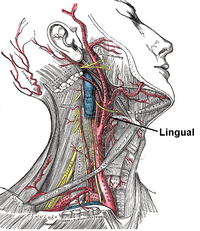Subclavian artery. (TA: subclavian artery) It is an artery in the neck . There are two; the right arises from the brachiocephalic trunk , to the left from the arch of the aorta , and the left arises directly from the aorta.

Source
It originates, to the right, from the brachiocephalic arterial trunk, and to the left from the aortic arch behind the primitive carotid .
Route and direction
The left subclavian is longer than the right as it first ascends vertically in the thorax. Both are directed outward and slightly forward, passing over the first rib between the anterior and median scalene muscles .
Termination
It ends in the space between the clavicle and the first rib.
Divisions
The subclavian artery is divided into 4 parts (left subclavian artery) and 3 parts (right subclavian artery):
- Thoracic portion: gives branches that supply the thoracic structures (exclusively the left subclavian).
- Pre-scalenic or intrascalene portion: the subclavian vein and artery separate, leaving the vein in the ventral part of the anterior scalene muscle and the artery behind (between the anterior scalene and the middle scalene, together with the brachial plexus).
- Scalenic or interscalene portion : deep to the anterior scalene.
- Post-scalenic or extrascalenic portion: the vein remains in the ventral part of the artery, and both are related to the brachial plexus.
Anatomical relationships
Relationship is called the condition of proximity between two anatomical structures to the point of being in contact. Knowledge of anatomical relationships helps practitioners navigate through the intricate organism of a living being.
Prescalenic portion: in this portion, both subclavian arteries follow different paths. The left subclavian artery is related in its intrathoracic path :
- In front: with the left primitive carotid artery and the pneumogastric nerve .
- From behind: with the bodies of the cervical vertebrae.
- Inside: with the esophagus , trachea , left recurrent laryngeal nerve , and thoracic duct.
- Outside: with the pleura and the lung .
Location
- In front: with the subclavian loop and the phrenic nerve (does not touch the pneumogastric nerve). With the subclavian vein and the brachiocephalic vein, the infrahyoid muscles and the sternoclavicular joint (joint between the sternum and the clavicle).
- Behind: with the recurrent laryngeal nerve, the pleural dome and its suspensory, vertebropleurocostal and vertebropleural ligaments .
- Below: with the endothoracic fascia, the subclavian loop and the anastomosis of the phrenic nerve with the lower cervical ganglion .
- Above: with the thoracic duct .
The right subclavian is related
- In front: with the pneumogastric nerve, the subclavian loop, and the phrenic nerve. With the subclavian vein and the brachiocephalic vein, the infrahyoid muscles and the sternoclavicular joint.
- Behind: with the recurrent laryngeal nerve, the pleural dome and its suspensory, vertebropleurocostal and vertebropleural ligaments.
- Below: with the endothoracic fascia, the recurrent laryngeal nerve, the subclavian loop and the anastomosis of the phrenic nerve with the inferior cervical ganglion.
Interscalene portion
- In front: with the anterior scalene muscle .
- From behind: with the brachial plexus and the posterior scalene muscle.
- Bottom: with the first rib.
- Above: with the brachial plexus.
Postscalenic portion
- Inside: with the first fingering of the serratus major muscle .
- Outside: with the medial aponeurosis , clavicle and subclavian muscle.
- From behind: with the brachial plexus .
Collateral branches
It has nine collateral branches that can be classified according to the trunks from which they are born or according to their path.
Depending on the arterial trunks
They are generally born from five trunks:
- Vertebral artery.
- Cervico-intercostal arterial trunk.
- Superior intercostal artery.
- Deep cervical artery.
- Internal mammary artery.
Thyrobicervicoscapular trunk
- Inferior thyroid artery .
- Ascending cervical artery .
- Superficial transverse cervical artery.
- Superior scapular or suprascapular artery.
- Posterior scapular artery.
Depending on your journey
Along its path, the collateral branches can be divided into 3 groups:
- Ascendants:
- Vertebral artery.
- Inferior thyroid artery.
Descending
- Superior intercostal artery.
- Internal mammary artery .
External
- Superior scapular artery.
- Posterior scapular artery.
- Superficial transverse cervical artery.
- Ascending cervical artery.
- Deep cervical artery.
Terminal branches
- Finally, it continues with the axillary artery.
Distribution
It is distributed to the neck, chest wall, spinal cord , brain , meninges, and upper limbs.
